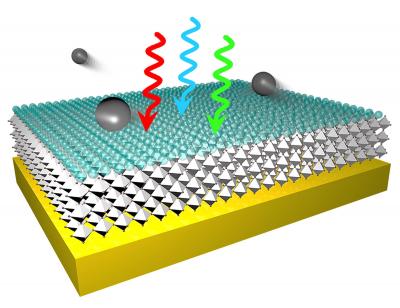Rice University scientists, in collaboration with a team from Los Alamos National Laboratory (LANL), have reported a technology that could dramatically reduce the cost of semiconductor electron sources, key components in various devices that range from night-vision goggles and low-light cameras to electron microscopes and particle accelerators.
 Perovskite semiconductors (silver) treated with a layer of cesium (blue-green) could be tuned to emit free electrons (gray) over both visible and ultraviolet spectra (colored arrows), and a layer of cesium could regenerate degraded photocathodes.
Perovskite semiconductors (silver) treated with a layer of cesium (blue-green) could be tuned to emit free electrons (gray) over both visible and ultraviolet spectra (colored arrows), and a layer of cesium could regenerate degraded photocathodes.
Billions of dollars are spent each year on photocathode electron sources made from semiconductors containing rare elements like gallium, selenium, cadmium and tellurium. "This should be orders of magnitude lower in cost than what exists today in the market," said study co-corresponding author Aditya Mohite, a Rice materials scientist and chemical engineer. He said the halide perovskites have the potential to outperform existing semiconductor electron sources in several ways.
Another advantage is that perovskite photocathodes are made by spin coating, a low-cost method that can easily be scaled up, said Mohite, an associate professor of chemical and biomolecular engineering and of materials science and nanoengineering.
"We also found that degraded perovskite photocathodes can be easily regenerated compared to conventional materials that usually require high-temperature annealing," he said.
The researchers tested many halide perovskite photocathodes, some with quantum efficiencies (a description of how effective a photocathode is at converting light to useable electrons) as high as 2.2%. They demonstrated their method by creating photocathodes with both inorganic and organic components, and showed they could tune electron emission over both the visible and ultraviolet spectrum.
"If each incoming photon generates an electron and you collected every electron, you would have 100% quantum efficiency," said study lead author Fangze Liu, a postdoctoral research associate at LANL. "The best semiconductor photocathodes today have quantum efficiencies around 10-20%, and they are all made of extremely expensive materials using complex fabrication processes. Metals are also sometimes used as electron sources, and the quantum efficiency of copper is very small, about .01%, but it's still used, and it's a practical technology."
The cost savings from halide perovskite photocathodes would come in two forms: the raw materials for making them are abundant and inexpensive, and the manufacturing process is simpler and less expensive than for traditional semiconductors.
"There is a tremendous need for something that is low-cost and that can be scaled up," Mohite said. "Using solution-processed materials, where you can literally paint a large area, is completely unheard of for making the kind of high-quality semiconductors needed for photocathodes."
Photocathodes operate according to Einstein's photoelectric effect, releasing free electrons when they are struck by light of a particular frequency. The reason quantum efficiencies of photocathodes are typically low is because even the slightest defects, like a single atom out of place in the crystal lattice, can create "potential wells" that trap free electrons.
"If you have defects, all your electrons are going to get lost," Mohite said. "It takes a lot of control. And it took a lot of effort to come up with a process to make a good perovskite material."
Mohite and Liu used spin-coating, a widely used technique where liquid is dropped onto a rapidly spinning disk and centrifugal force spreads the liquid across the disk's surface. In Mohite and Liu's experiments, spin-coating took place in an argon atmosphere to limit impurities. Once spun, the disks were heated and placed in high vacuum to convert the liquid into crystal with a clean surface.
"It took a lot of iterations," Mohite said. "We tried tuning the material composition and surface treatment in many ways to get the right combination for maximum efficiency. That was the biggest challenge."
He said the team is already working to improve the quantum efficiency of its photocathodes.
"Their quantum efficiency is still lower than state-of-the-art semiconductors, and we proposed in our paper that this is due to the presence of high surface defects," he said. "The next step is to fabricate high-quality perovskite crystals with lower surface defect densities."